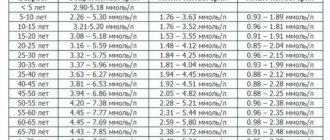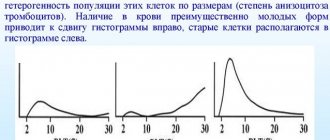One of the parameters taken into account when performing a complete blood test is the average platelet volume. These blood cells are directly involved in blood clotting, ensuring the formation of a blood clot and restoring the integrity of the blood vessel. The indicator is designated as MPV in a blood test, but what it is and what it is connected with is not clear to the patient.
Platelets in the blood
Platelets are the smallest formed elements of blood. They do not have a nucleus, but perform many vital functions. Their main tasks are to impart a certain viscosity to the blood and restore the integrity of the vascular wall if it is damaged. In this case, the formation of certain substances (fibrinogens) occurs, under the influence of which platelets turn into an active form. In this state, they gain the ability to flatten and stick together with each other and with the wall of the damaged vessel, forming a thrombus (a kind of plug that closes the damaged area and helps stop bleeding).
The formation of platelets occurs in the bone marrow, and due to the fact that their life is no more than 10 days, for normal functioning of the body it is necessary to constantly produce new cells. If the balance between the destruction of platelets and the formation of new ones is disturbed, a person has either a tendency to bleeding (the number of platelets decreases) or to excessive thrombus formation (at high levels). A blood test determines the amount of these formed elements per liter or microliter. The normal platelet count varies from 180x109 to 320x109/L in adults.
How to treat elevated MVP?
If a clinical blood test indicates an increase in MVP, you need to find the underlying cause. If it is physiological and characteristic of a given individual, then no measures are taken as such.
In case of pathologies, therapy is provided in a complex form:
- Blood thinners. Used to normalize blood to its natural thickness,
- The use of hormonal treatment for normal platelet production,
- Drinking large amounts of water and diuretics,
- Diet.
In life-threatening situations, doctors perform hemodialysis. A person’s blood passes through a device that retains platelets, as a result of which the level returns to normal.
If the platelet production disorder is caused by the bone marrow, a bone marrow transplant is performed.
Average platelet volume
The indicators determined by a general blood test are somewhat different today from those several years ago. Thus, many abbreviations have appeared that are incomprehensible to uninitiated people. One such mysterious value is MPV in a blood test. It's actually not that complicated. This abbreviation hides an indicator that determines the average platelet volume.
Due to the relatively short lifespan of platelets and their constant synthesis, formed elements are always present in human blood and are at different stages of their life cycle. At the same time, young and mature cells, as well as platelets, whose life cycle is already nearing completion, not only differ in size and saturation with biologically active substances, but also carry different functional loads. MPV in a blood test allows you to determine how many platelets of different sizes are in the blood at the moment.
General information
It should be noted that an increase in the number of platelets and an increase in their average volume are different phenomena. The detection of a high level of red blood cells indicates their quantitative increase and does not characterize the qualitative composition.
Analysis of the average volume of platelets of platelets does not reflect their quantitative presence in the blood, but the ratio of mature and young elements. That is, this indicator is decisive for assessing the usefulness of platelets.
Their activity and ability to form a life-saving thrombus at the site of vessel injury depends on the size and quality of the plates.
Mature cells, characterized by their small size, make up a smaller portion of the total volume of blood studied. Immature (young) blood cells are larger and, accordingly, occupy most of the fluid volume.
This ratio is considered normal. Its violation indicates the presence of pathology in the body.
Normal MPV values
To determine the average platelet volume, blood is taken from a vein. After this, 5 ml are examined using the fluorescence cytometric method. The result is a histogram - a curve showing the MPV in a blood test. The norm for this indicator varies from 7.5 to 11 fL. The histogram allows you to estimate the number of platelets of different sizes. Normally, the content of mature cells should occupy 90% of the total platelet mass, young - no more than 0.8%, degenerative - 0.2%, old - 5.6%. In this case, the predominance of immature elements shifts the histogram to the left, and the predominant content of old cells shifts to the right. It is worth considering that deciphering the results can reveal certain changes in MPV (blood test) indicators even if the absolute platelet count is normal.
Next, let's talk about what reduced and increased MPV means.
How to keep your MVP metrics healthy?
To maintain the average volume and MVP within normal limits, it is necessary to do prevention, which consists of the following actions:
- Take a clinical blood test with MVP indicators at least once every three months,
- Carefully select medications during treatment. Some drugs have a negative effect on platelet function,
- Bring your diet back to normal. Reduce the amount of fatty foods, and instead of fatty meat, it is recommended to use fish, turkey or rabbit meat,
- Drink enough water.
Following all these recommendations, you should consult a doctor if:
- Sudden weight loss
- Constant fatigue, drowsiness,
- Changes in skin tones
- Nosebleeds,
- A sharp decline in health
- Tachycardia.
At any MVP level, it always reflects the level of human health. Timely blood tests will allow you to detect pathologies, if any, in advance and begin treatment. Indeed, in the early stages of the disease there are almost no external factors.
Treatment in the early stages is much easier and cheaper!
Blood test: MPV lowered
This picture can be observed if in a blood test, against the background of a normal absolute platelet count, the average volume is below normal. This is manifested by a significant predominance of old cells in the histogram. In this case, a low MPV in a blood test will signal a dangerous condition such as thrombocytopenia (platelet content less than 100x109/l), in which extensive bleeding is possible due to decreased blood clotting.
The causes of this condition can be hereditary factors, diseases of the blood and other organs, and the use of certain medications. There are three main points in the mechanism of development of thrombocytopenia:
- reduction or cessation of the synthesis of young cells - this can occur with various pathologies of the liver, thyroid gland, anemia, intoxication caused by alcohol and other toxic substances, as well as when taking certain medications;
- if platelets are destroyed faster than they are synthesized, this may result from certain immune pathologies (thrombocytopenic purpura), disseminated intravascular coagulation syndrome, or blood transfusion;
- violation of the distribution of platelet mass - in a normal state, almost half of the platelets are in a kind of depot, the role of which is played by the spleen; in some diseases (tuberculosis, hepatitis) the number of deposited platelets can reach 90%.
What does a decrease in MPV mean?
A decrease in MPV may mean an enlarged spleen (splenomegaly), the presence of liver cirrhosis, hypoproteinemia, kidney disease, and thyroid pathologies. The platelet index decreases in aplastic anemia, septic thrombocytopenia, congenital megakaryocytic hypoplasia, Wiskott-Aldrich syndrome, X-linked thrombocytopenia with platelet microcytosis, thrombocytopenia caused by immunological destruction of cells, as well as during chemotherapy and during pregnancy. A significant decrease in MPV in the blood of a pregnant woman indicates a threat of miscarriage.
Symptoms characteristic of low MPV
The symptoms that accompany situations where MPV in a blood test is low is due to two factors: a violation of blood coagulation mechanisms and increased permeability of the vascular walls. Externally, this manifests itself as the following signs:
- multiple subcutaneous hemorrhages, most often located on the anterior surface of the limbs, abdomen, and chest;
- frequent nosebleeds;
- women have long and heavy menstruation;
- hemorrhages in the retina of the eyes.
MPV level increased
However, there are situations when, when determining MPV, a blood test (deciphering) shows an excess of normal platelet levels. In some cases, their number can significantly exceed 400x109/l. This condition is called thrombocytosis and can lead to quite serious pathologies associated with increased thrombus formation. A distinction is made between relative thrombocytosis (readings exceeding the upper limit of normal by 100–200 thousand units) and critical, when a complete blood count shows twice the normal values. MPV can be so elevated for various reasons, so it is necessary to conduct a more in-depth examination, find out the cause of thrombocytosis and try to eliminate it.
What to do if the indicators are increased?
Did a general blood test reveal more platelets than normal? It is necessary to begin searching for the true cause of the patient’s pathological condition. If physiological signs are detected, there is no need to do anything serious; it is only important to properly treat the existing disease. If pathological development is noted, then, as a rule, you need to deal with it in two directions:
- Use blood thinners. They are necessary to reduce the load on the heart muscle and reduce blood density.
- Take hormonal medications to normalize the functioning of the thyroid gland.
All medications should be used as prescribed by a specialist, including the dosage. If you take medications chaotically, it is possible that another pathology may develop.
Reasons for increasing MPV
Modern medicine makes it possible to determine not only an increase in the total number of platelets in the blood, but also to find out which types predominate. This is often important for diagnosing diseases. For example, the number of young platelets increases after surgery or signals internal bleeding or prolonged blood loss. High levels of old platelets indicate an oncological process. Degenerative forms increase with disturbances in the hematopoietic process. Thrombocytosis most often accompanies the following conditions:
- exacerbation of chronic processes in the gastrointestinal tract and skeletal system;
- blood diseases;
- surgical interventions;
- oncology;
- as a side effect of certain medications.
When is an increase considered normal?
Active production of a large number of platelets by the bone marrow becomes a consequence of the body’s compensatory reaction.
It helps stop bleeding, but leads to an imbalance between mature and young cells. The reason for the increase in the indicator in such situations is associated with restorative physiological processes in the body.
Such deviations are considered normal; they do not indicate pathology. Among them are the following situations:
- after surgical operations;
- in women during the menstrual cycle;
- multiple injuries accompanied by heavy bleeding;
- the use of drugs that stimulate hematopoiesis;
- features of processes in children caused by inferiority of the hematopoietic system.
The absence of a natural increase in platelets against the background of the described situations indicates bone marrow failure and necessitates further examination and correction of the condition.
MPV during pregnancy
Pregnancy requires a woman’s body to restructure all its functions, and these changes primarily affect the circulatory system. The need to form an additional (placental) circulation requires an increase in the total volume of circulating blood. On average, normal platelet counts in a pregnant woman are considered to be 150–380x109/l. However, deviations from the norm in this condition can lead to serious consequences. That is why a woman should undergo regular laboratory tests throughout her pregnancy.
If pregnancy is accompanied by severe toxicosis, then vomiting and other intestinal disorders can lead to dehydration, which, in turn, will affect the level of platelets - it will increase sharply. During pregnancy, levels should not exceed 400x109/l, otherwise pathological processes may begin, leading to platelet aggregation and the formation of blood clots in the vascular bed. In the early stages, such pathologies can lead to fetal loss, and in the later stages they are fraught with the occurrence of blood clots in the vessels of the legs, accompanied by the development of varicose veins. In order to avoid this, you can use orthopedic knee socks.
No less dangerous is a decrease in platelet levels below 140x109/l. In the early stages, this can cause bleeding and even the risk of fetal loss. Manifestations of thrombocytopenia during pregnancy can include the appearance of bruises on the body even after slight touches, bleeding gums, and nosebleeds. In later stages, thrombocytopenia can cause large blood loss during childbirth and bleeding in the child.
Thus, the average platelet level is an important indicator of the condition of the human body. It allows you to determine the possibility of a particular pathology at an early stage and take measures to prevent it.
What to do if platelets have dropped?
With low MVP, thrombocytopenia actively develops.
If the indicators keep the bar below normal, then the histogram shows a low number of working cells, while there are many old and newly appeared ones.
Aging cells cannot perform their functions at full capacity and do not carry a biological load, but those created are not yet ready for this.
The disease is especially in that with a sufficient number of platelets, their quality can contribute to the development of pathologies.
There are three types of thrombocytopenia:
- The bone marrow reduces the synthesis of newly appeared cells. This may be a consequence of chronic alcoholism and problems with the liver or spleen.
- Increased platelet death indicates diseases of the spleen and liver, and also as a result of autoimmune diseases.
- Imbalance of platelet mass during distribution - many platelets are stored in the spleen, when they are not in demand.
It is difficult to detect thrombocytopenia in the early stages, due to the fact that external symptoms do not appear. But when tested for MVP, this disease can be detected.
At later stages, the manifestations of external symptoms of the disease begin:
- Nose and gums bleed
- Callos and urine contain blood,
- Vomiting blood
- Longer and more unpleasant menstruation in women,
- Hemorrhages under the skin, with a significant area.
Low platelet levels also occur for the following reasons:
- Blood diseases (congenital),
- Oncology,
- Viruses and microbes in the body.
Reduced MVP may indicate the following diseases:
- Enlarged spleen
- Heart attack
- Some medications
- Inflammatory diseases
- Oncology,
- and others.
If the platelet count decreases in pregnant women, there is a possibility of miscarriage.
During pregnancy, the number of these cells in the blood should be monitored more frequently and more carefully.











